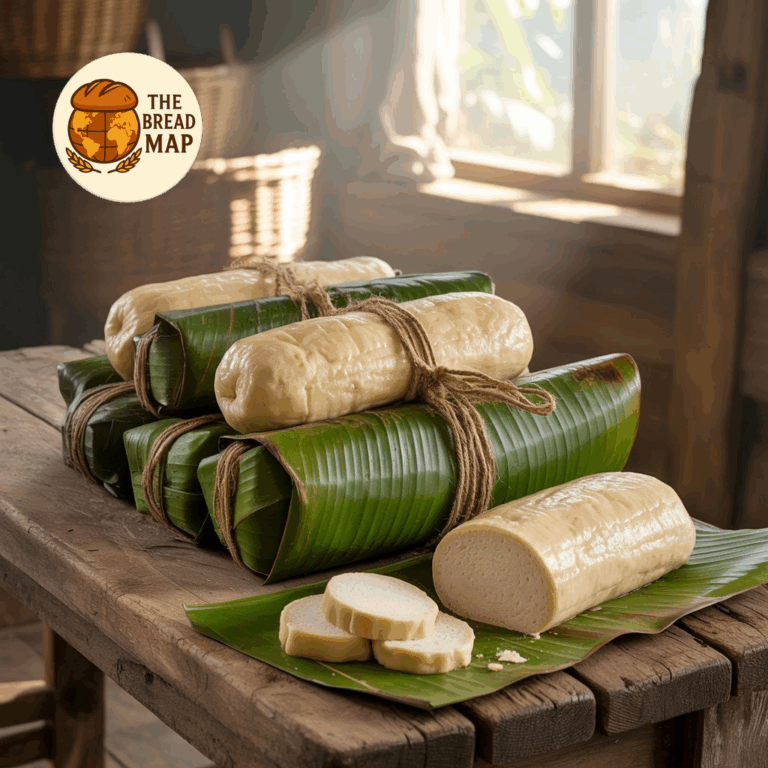
Introduction
Across the lush rainforest landscapes and mighty riverbanks of the Democratic Republic of Congo, there’s one humble food that connects people across rural villages and bustling cities alike—Chikwangue (also called Kwanga). At first glance, this tightly wrapped, leaf-covered bundle may look simple. But inside lies a story of ancestral tradition, agrarian rhythm, and daily nourishment. With its dense texture, earthy depth, and slightly sour tang, Chikwangue is not just a side dish—it’s a centerpiece of Congolese identity.
Historical Background
Chikwangue’s roots reach deep into Central Africa’s precolonial past. For centuries, cassava—a drought-resistant tuber introduced to Africa from South America by Portuguese traders in the 16th century—became fundamental to the local diet. Its storability, generous yields, and ability to grow in poor soil turned it into a lifeline for families across the Congo River basin. But cassava is toxic in its raw form and must be processed to remove harmful cyanogenic compounds. Traditional fermentation and boiling, passed down through generations, not only makes it safe but also infuses it with the unmistakable character that defines Chikwangue today.
Region of Origin
Although Chikwangue is beloved across many Central African countries, it is particularly emblematic of the Democratic Republic of Congo, especially in the central and western provinces like Bandundu and Bas-Congo (Kongo-Central). In rural communities along the Congo River, making and sharing Chikwangue is a daily ritual. Markets brim with leaf-wrapped rolls, often homemade or crafted by local vendors, sustaining urban dwellers who crave a taste of their village roots.
Ingredients and Preparation
Creating Chikwangue is both an art and a science, requiring patience, skill, and deep local knowledge. It’s typically made with just a few ingredients:
- Cassava tubers – peeled, washed, and fermented
- Water – used during the fermentation and dough preparation
- Banana or palm leaves – used for wrapping and steaming
The preparation process involves several labor-intensive steps:
- Fermentation: Cassava is soaked in water-filled pits or containers for several days until it breaks down into a soft, fragrant pulp.
- Pounding and Straining: The fermented pulp is pounded into a smooth dough, then squeezed to remove excess water and bitterness.
- Wrapping: The dough is portioned and tightly wrapped in banana or palm leaves to form cylindrical loaves.
- Boiling/Steaming: The wrapped loaves are boiled or steamed for up to 4–5 hours until firm.
Once cooled, Chikwangue becomes sliceable and portable—ideal for long journeys, market days, or busy weeks when cooking time is short. It has a long shelf life when kept in its leaves, adding to its practicality in environments where refrigeration is rare.
Cultural Importance
Chikwangue is more than a traditional starch—it is a ritual and reassurance. Served alongside grilled fish from the Congo River, rich peanut stews, or fiery pili-pili sauces, it’s often the foundation of the meal. It’s eaten with the hands, symbolizing connection and community.
Its preparation is often communal, especially in rural settings where women and neighbors gather to ferment and wrap large batches for feasts or special occasions like weddings and funerals. It’s said that a well-made Chikwangue reflects the cook’s love and patience—its texture and fermentation a testament to care.
In modern Congolese cities, as life accelerates and imported foods increase, Chikwangue holds steady as a culinary symbol of continuity. For those who have emigrated abroad, unwrapping a Chikwangue loaf brought home from a local African shop can bring tears of nostalgia.
Embodying resilience, simplicity, and deep roots, Chikwangue is not just a bread—it’s a living tradition that feeds both body and soul.
Leave a Reply